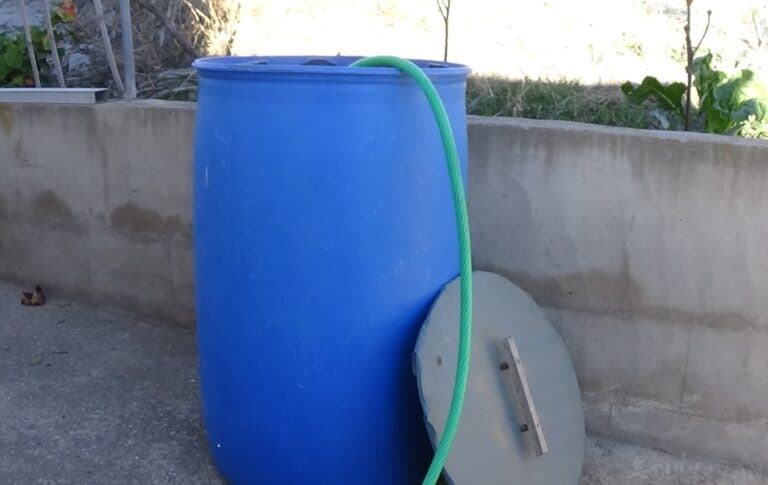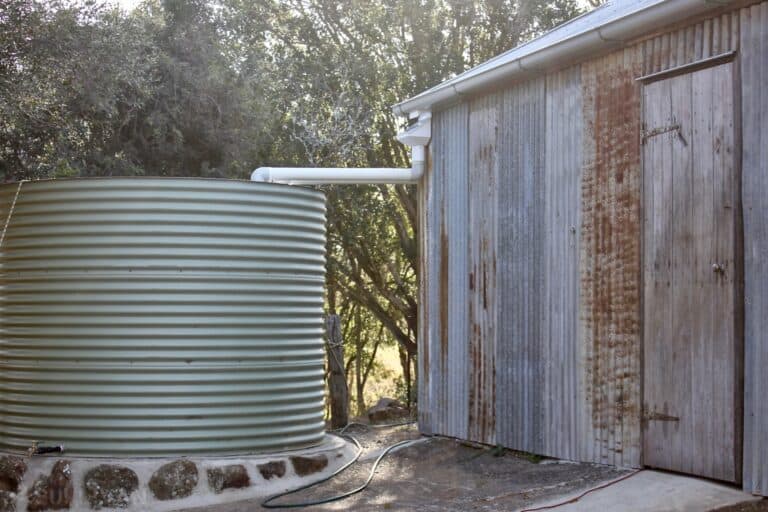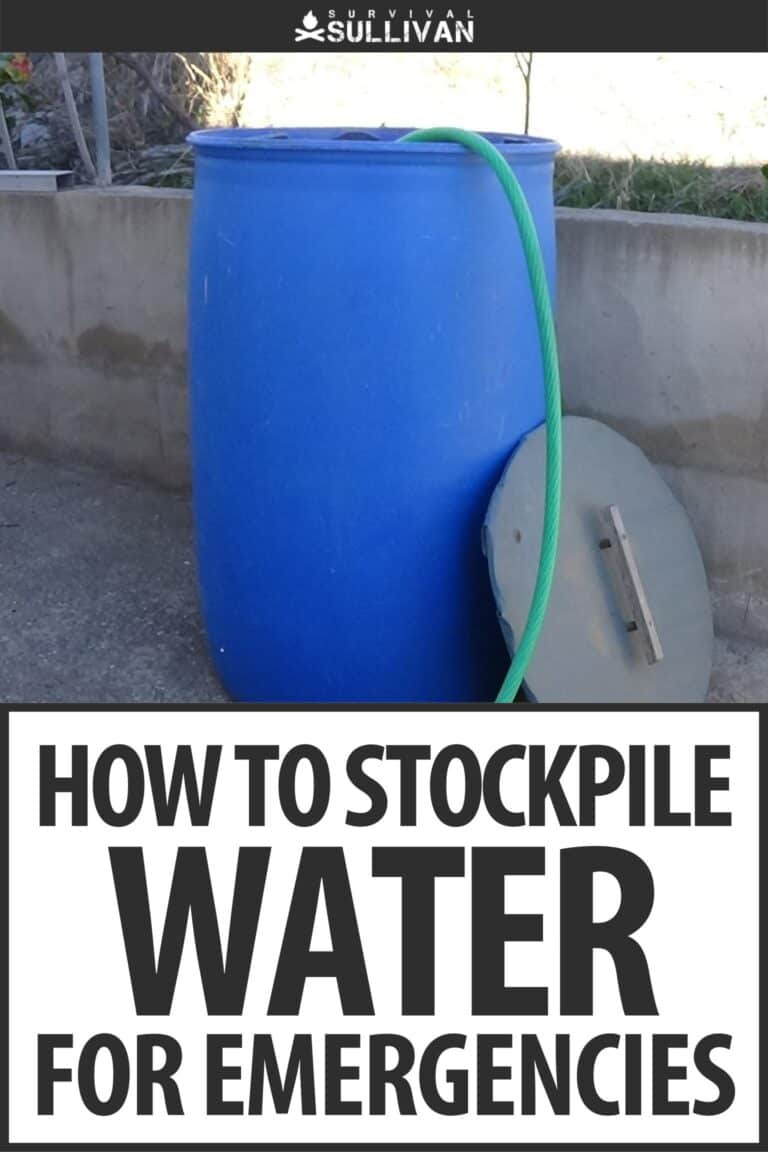One of the greatest challenges to preparing your retreat for when SHTF is knowing how much water to store and how to store it.

In a disaster situation, you never know what may happen to your water sources – you may be unable to collect water for a long period of time, or have to fend off zombies from stealing your water, or may be unable to so much as leave your home. Any number of things could cause you to lose your water sources.
The big questions, then, are how much water should you store, and how do you store it? Planning for the day you can’t turn on your faucet for water will be crucial to your survival in a disaster.
Table of Contents
Your Usual Water Supply Will Probably be Compromised
Water that comes from any faucet in or near your home might become obviously contaminated in the aftermath of an event.
Even worse, it might appear and smell normal, but may be invisibly contaminated with hazardous substances as a result of damage or lack of human oversight.
To function safely, public water supplies require an extensive network of infrastructure and facilities as well as competent human supervision and input. Take away or impair any of those elements and your usual water supply might become contaminated.
To that end, many preppers plan to store drinking water in bottles or jugs as the primary solution to emergency water storage.
It is generally a good idea, and having known fresh, potable and portable water on hand is never going to hurt. This tried and true plan is especially good if you are only facing a short-term survival scenario or disaster situation.
The main problem with this strategy is that your bottled water supplies will eventually run out: without any access to your normal water sources in your home or around town you may go through water at an alarming rate. This is especially true if you are working your tail off or live in a hot, humid climate.
Consider also that you’ll need water for more than just drinking. You’ll need some for cooking and at least a little bit for keeping yourself clean, a factor which should not be overlooked. Is using bottled water for the purpose ideal, the highest and best use?
I don’t think so. You’ll want more water, to be sure, abundant enough that you can take care of all your survival needs besides hydration alone.
How Much Water Do You Need?
Because you never know what will happen at TEOTWAWKI, we are going to assume that in the event of a disaster, you will be completely unable to access any external source of water.
This means you will only be able to live off of your stockpile alone. While this may not be true, it is better to plan for the worst, than to plan for the best.
The first thing to consider when planning how much to stockpile is how much water you (and your family) will need to consume in order to survive. One common mistake a lot of preppers make is hoarding too much food and not enough water. To explain this, we refer to the rule of 3s:
- You can live for 3 minutes without air.
- You can live for 3 hours without shelter.
- You can live for 3 days without water.
- You can live for 3 weeks without food.
If you’re preparing, now, though, you have the luxury of being able to plan to have all four of these things. But taking one for granted and over preparing for the others could be a fatal mistake.
One common guideline for storing water is that an active person will generally need a gallon of water per day. Half of this will be consumed, while the other half is for personal hygiene.
This technically means you can store less and simply not be as hygienic, but that comes with its own problems for survival as well (namely, disease and other such things).
Here are some other questions:
- Is anyone in your household sick or injured?
- Is anyone in your household pregnant or nursing?
- Do you have any children in your household?
- Do you live in a very hot climate?
If you answered yes to any of these, you may have a greater demand for water (up to double or triple the normal amount).
We will continue with the assumption that one person needs one gallon per day, but keep in mind any extenuating circumstances you may have that may alter individual water needs. Here’s a table with some easy calculations for stockpiling:
| Number of People in Household | Length of Time | Water Needed |
|---|---|---|
| 1 | 3 months | 90 gallons |
| 1 | 1 year | 365 gallons |
| 2 | 3 months | 180 gallons |
| 2 | 1 year | 730 gallons |
| 4 | 3 months | 360 gallons |
| 4 | 1 year | 1,460 gallons |
| 4 | 3 years | 4,380 gallons |
Again, this is accounting for consumption and personal hygiene only. This does not include pets, gardening, or any other use for water. Pets generally need a gallon of water every three days (depending on the size of the pet and type).
However, if you’re bugging in, we will simply assume that you are unable to tend to livestock or outside gardens.
You will need some water for cooking, but this is dependent on what food you are cooking and how much of. If you are limited on fuel as well, you may not even be doing much cooking, so this number really depends on your situation.
Our advice? Stockpile what you know you’ll need based on our table above, then stockpile some more for cooking and other needs you may have.
Where Should You Store Your Water?
There are a number of containers available for storing water; however, some are more suitable for this purpose than others.
For example, you should generally not reuse milk jugs to store water, as it is nearly impossible to fully remove the milk proteins from the container, and these will eventually provide a habitat for bacteria to grow in. Other types of plastic may release toxic chemicals into your water.
So how do you know what’s safe? First, let’s talk about plastic containers. There are seven commonly used types of plastic:
- Polyethylene terephthalate (PET/PETE/polyester)
- High density polyethylene (HDPE)
- Polyvinyl chloride (V/Vinyl/PVC)
- Low density polyethylene (LDPE)
- Polypropylene (PP)
- Polystyrene (PS)
- Other/Polycarbonate (PC)
The three types that are considered safe for common use around food and drink are: high density polyethylene (HDPE), low density polyethylene (LDPE), and polypropylene (PP). However, this is very dependent on the conditions that the containers are stored in.
For example, PET/PETE is commonly used in soda bottles and juice bottles, and if you’re not storing water for a very long time and the bottles are not stored in hot conditions, the likelihood that PET/PETE will leak chemicals into the water is low.
Even with plastic containers made from HDPE or LDPE, however, there is a chance that they can leak the chemical nonylphenol (short explanation: this is bad) into your water if they are stored in sunlight.
Polypropylene (PP) is commonly used for hot food storage because it will not leak chemicals with the application of heat.
Considerations for Long Term Storage of Water Supplies
Quality Concerns
Before we get down to the nitty gritty of storing our own water in various containers for emergencies, let’s examine that bottled (or jugged) drinking water you have stashed.
Most folks assume that their water won’t spoil- it is water, after all- and presuming the water is obtained from a factory source with its seals intact, they are usually right.
However, stored water may deteriorate with time, in a manner of speaking. Even though it is factory produced and factory sealed, your drinking water can simply evaporate over time.
You’ll also find this is a significant issue when storing your own water in a container or tank of your choosing. Another issue is the decline in the taste of the water.
Even if proper storage conditions are maintained using purpose-manufactured water storage containers, water is notorious for acquiring an unpleasant taste over time.
Water is a solvent, and this characteristic has led to much discussion about whether or not it starts to pickup hazardous chemicals or particles from the containers it is filling.
The results seem to say “yes” but the negative effects, if any, are mostly inconclusive.
Unless you are drinking a huge amount of water that has been stored for an exceptionally long period of time, studies and individual expert findings indicate that bottled or “tanked” water that has acquired that terrible flavor shouldn’t harm you.
Even so, you are well advised to rotate your stored water as you would any other consumable in long-term storage.
Container Considerations
Having the appropriate containers is important not just for convenience and quantity but also for furthering your survival strategy.
Your water supply will be portable, semi-portable or totally immobile depending on the size of your container and the method of installation, if any. This factor can have a significant impact on the ease and costliness of rotating your water supply over time.
Also, keep in mind that any water storage container you choose for storage of drinking water should be food grade.
Non-food grade containers might suffice when you are desperate or for short term use, but it’s potentially dangerous to do so long term: non-food grade water storage containers may leach hazardous chemicals into your water!
Try to use food grade containers designed for water storage whenever possible.
Container Types
Water Cans
Water cans (or jugs) are often similar in form to similarly shaped military style fuel cans, and colloquially called jerry cans.
Usually carrying between 3 and 5 gallons, when full they are pretty heavy, but are still man-portable and can easily attach to specific carriers and racks on automobiles.
Highly mobile, they are generally not so big or bulky that it is difficult to rotate or clean them.
Stackable Containers
Stackable water containers are often comparable in size to small or medium water cans, but are intended to be stackable. Nesting together snugly, these are a safe and secure option for placing inside a closet or corner of a storage room.
This makes them the ideal choice for incrementally increasing your water storage capacity over time while minimizing rotation and cleaning requirements.
Stackable water containers are handy enough that they remain pretty portable, though they may or may not be as easy to carry as a water can, especially if they lack a handle.
Bathtub Basin
A bathtub basin is a big, plastic bag with a valve and a spigot that can be placed into any normal residential bathtub before being filled from the tub faucet.
These are ideal for prepper use since they are readily available, easy to store in a closet nearby and entirely out of the way until you need them.
At the onset of a disaster, or right before if you have warning, you set the bag into your bathtub, unfold it, open the cover and fill it with dozens of gallons of water in minutes, providing you a sizable supply.
Water Barrels
Water barrels, which are one of the most popular types of “high capacity” water storage, are typically used as part of rain catching system and are virtually guaranteed to used in tandem with rooftop rain catchers.
Water barrels can store anywhere between 40 and 55 gallons of water, and can be linked together using connections to easily store more than that. The water within is usually accessed via a tap or a simple hand-operated pump.
Any water barrel kept outside must be able to withstand direct UV rays and all sorts of pests if it is going to be used as a supply of drinking water.
Water Tanks
Traditional, large water tanks are frequently seen on farms, homesteads, and remote off-grid dwellings where access to public water is either impossible or horribly inefficient.
Underground or above-ground, these tanks can be fed by a wide range of sources and are frequently bolstered by rain catching systems.

Most hold several dozen or hundreds of gallons of water, and are more than capable of sustaining a large group for a lengthy amount of time with careful usage.
It’s definitely a good idea to add a water filtration system if intended for drinking water considering how difficult it can be to completely rotate the substantial supply these things hold.
Glass
Glass is another option for storing water, but may be less convenient than plastic for a number of reasons. First, it is heavy and easily breakable. Like plastic, you will need to be sure it is food-grade glass and stored in a cool, dark area.
Some upsides: Glass is impermeable, so it can be stored near other supplies without the water being at risk, and it will be much harder for pests or rodents to get into.
Over time, vapors from stored fuel or other chemicals can penetrate plastic; on top of that, plastic is easier for pests or rodents to get into.
Not only that, but glass will be much harder for zombies to steal because of its weight (not that it would be easy to make off with a 260-gallon water tank in the first place!).
Metal
The best option for storing water in a metal container is by far and away stainless steel, but one major downside is that large stainless steel containers for water cost much more than plastic.
Some upsides are that, like glass, stainless steel is impermeable so vapors from nearby stored chemicals won’t eventually leak into the water. It’s also lighter than glass, so if you want to move your stores around, it will be easier.
Metal can also be stored somewhere that gets a lot of light, unlike glass and plastic.
However, you should still check that your stainless steel is food-grade, and on top of that, you’ll probably want some sort of protective coating on the inside to prevent the chlorine from your tap water corroding the steel.
No matter what you decide to store your water in, do your research on the material and any precautions you need to take.
You don’t want to end up in a disaster with contaminated water. In fact, because it can be so easily contaminated, most preppers filter their water in various ways to be sure it is still safe.
How Do You Filter and Purify Your Water?
There are a variety of options for filtering and purifying your water, including:
- Using a store-bought filtration and purification system. These come in all shapes and sizes; it’s best to choose the one that suits your situation best. Be sure to look for a system that both filters and purifies the water, as these are technically two different processes (one to remove dirt/sediment/etc. and one to remove viruses and bacteria).
- Boiling the water to kill any viruses or bacteria that may be present. If you use this method, be sure to boil the water for at least three minutes to ensure that it is safe.
- Using a chemical like bleach (about 8 drops to every gallon), iodine, or chlorine. You should take care with chemicals, as the material that you store your water in could react with them. You also will want to make sure that you don’t use too much, as this could be harmful when you drink the water as well.
Even if your water was clean when it went into storage, there’s no guarantee that it’s still safe after being stored.
Having a filtration and purification system in place ensures that your storage water remains safe for consumption. Some people even suggest rotating your water supply every 6 months to a year, but there’s very little evidence for its effectiveness.
Ready To Stockpile Water?
Many people recommend having more than one stockpile in more than one place if you want to be truly prepared. This is a great option for anyone who has a retreat or a lot of space, because it ensures that you have a location for bugging out when you need to.
This also means that if your stored water supply in one place happens to go bad for whatever reason, you’ll have somewhere else with water to run to. It’s always good to have a backup plan, even for your backup plan.


My name is Teresa Fikes. I am a Homesteader, survivalist, prepper, historian, and writer plus much more all in one package deal. I was raised on a small family farm were I was taught at an early age to survive off the land without the help of modern conveniences. I am a writer by profession and a Homesteader by Blood, Sweat, and Tears.

I store 310 gallons of my own well water mixed with purifier in a brand-new plastic tank designed to store industrial acid. I change it every three years. I also installed a “SimplePump” in my 220′ well, this is a hand pump that fits right alongside my submersible electric pump; the electric pump is at 200′ and the SimplePump is at 150′. Normal water level in the well is 40′ from the surface.
The SimplePump pumps directly into my pressurized water tank in the house, and this allows me to flush toilets and use sinks upstairs. One hour of hand pumping delivers 30 gallons into the pressure tanks – enough for one day. My septic tank is gravity fed and pumped every year.
I disguise the SimplePump by surrounding it in a little potting shed that is installed over the well head. The potting shed is very strongly built and has a hinged roof that folds back to allow me to pull and replace both the submersible electric pump and the SimplePump, when necessary. I hand pump at night so as to not alert the neighbors during a crisis. During Hurricane Sandy we were without electricity for nine days and nights; the SimplePump provided all our water needs.
Our Berkey is clear so it’s pretty obvious when it needs water and how much.
And for those stockpiling, order extra spigots.
I have stored about 100 half gallon and gallon containers. Mostly bottled water and juice containers. They are clean, dry and stored in cardboard boxes. Should the need arise, a quick rinse, then fill. An advantage of this, some, but maybe not all, of the water can depart, if the need arises.
In Australia outside of cities and towns every house hold has had large water tanks connected to thier roof gutters ,(eaves troughs) for at least the last century or more. I was born in 1944 and every house we ever lived in outside of town had at least one galvanized water tank. I am talking of tanks that hold thousands of gallons. I currently have two 5 thousand concrete tanks and a plastic tank that holds over 5 thousand gallons. It is usually dry during the winter here, on the tropic of Capricorn on the east coast of Aus., but we had a fairly dry summer just past so we are running out ofwater for the garden. We have had a bore (deep well) put down but are still waiting to get a solar powered pump for it. Then we will have all the water we need for the garden and orchard.
I have a couple of UBC (Universal Bulk Containers) that will hold over 300 gallons each. They were used ones and were obtained from a Farm Supply relatively inexpensive. They would make good rain water catchments. They held fertilizers and had to be flushed out.. I got them for watering our garden, toilet flushing. and filtered for clothes,dish and hand washing, bathing. Potable drinking water is stored in those 5 gal water jugs as well as some 2 ltr soda water bottles.
I live in Minnesota, it gets very cold here. I have water storage however if you lost utilities (heat) in the winter your six gallon plastic water containers would be big chunks of ice.
Don’t have a whole lot of space for storage. Our water supply is gravity fed. Fresh-water pond a 1/2 mile away. Septic is gravity fed. I think that a 10,600-gallon chlorinated pool counts as an emergency water supply for general use and maybe even drinking thru a suitable filter or even for barter.
Oh, and look up using Lugols iodine for emergency treatment of salmonella and water purification.